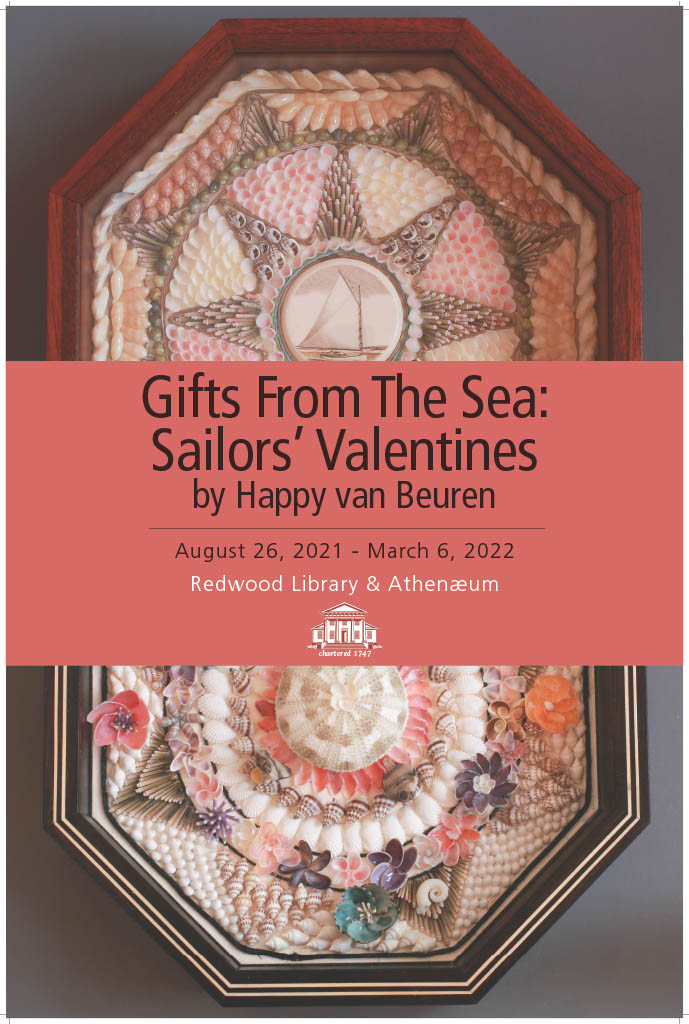
07 Sep Gifts from the Sea: Sailors’ Valentines by Happy van Beuren August 26, 2021 – March 6, 2022
Even as she continues to be a signal tastemaker in the cultural life of Newport, Happy van Beuren’s discretion and humility have masked an exceptional talent in the creation of dazzling sailors’ valentines that is largely unknown except to her closest friends and family.
In the context of the serene beauty of her home and garden, where many of the pieces shown here usually live, one might imagine them the result of her taste as a collector and lover of nature. But her creations in this exacting art form, displayed publicly here for the first time, reveal an enduring energy and adaptable creative spirit. If her eye for beauty has never wavered, it is now her dexterous hands and her art that have replaced her creative shot making on the tennis court and her legendary style on the dance floor.
Van Beuren has always enjoyed working with her hands, matching her pleasure in making things to her varied artistic inclinations: her practice has included drawing, watercolor painting and needlepoint. However, it is color, and the challenge of ordering its complexities, that has drawn her to sailors’ valentines. For it is in these beautiful and meticulous constructions that she finds the soothing benefits of pattern and symmetry. Henri Matisse, an artist equally enchanted by color, felt the same way, famously affirming that he dreamt of an “art of balance, of purity, and serenity.”
If valentines might bring van Beuren personal pleasure, it is fitting that they should in addition denote compassion and love. Made with care to signify caring, sailors’ valentines also celebrate nature’s bounty—so evident in Newport and Aquidneck Island—and our duty to preserve and share it. Tokens of the ties that bind, van Beuren’s creations are mostly given away, enabling her in this way to transmit to friends and family her special gifts gifted to her by the sea.
The Creative Process: Intuition and Design
The richly decorated works displayed here are the fruits of Happy van Beuren’s decade-long devotion to an art form that is as painstaking as it is historic. Originally introduced to sailors’ valentines in Boca Grande, Florida, her journey began first with lessons from a series of internationally known teachers, including the late Sandra Moran, widely held to be one of the greatest practitioners in the genre.
We can speculate that it is from the latter that van Beuren first absorbed the craftsmanship and meticulous design that characterizes her valentines. In fact, for all of their tidiness her creations often begin with her own more abstract intuitions, grounded in her attraction to the distinct colors of particular shells, their shape and size. While this sort of aesthetic clairvoyance precedes the reasoned calculations of pattern, the former must in turn be adapted to the octagonal format and design conventions of a valentine.
Valentines are made by arranging shells, seeds, small marine animals (urchins, crabs and seahorses), marine flora, small stones, as well as sand, and gluing them down on an octagonal cardboard backing. Whereas early practitioners created comparatively simple designs by way of an additive method of ‘stacking’ the seeds or shells, today most valentine artists begin with a printed pattern to guide their design. Discrete sections may be delimited by string, fabric or wire (cording), which also guide the setting of elements while giving an added level of finish to the completed work. All sailors’ valentines are mounted within an octagonal hardwood frame—the signature format of the art form— most often made of mahogany, cherry or walnut finished with various wood inlays.
While van Beuren might initially be drawn to certain shells and their color to initiate the creative process, the art of her sailors’ valentines is in the coordination of color, design, and theme. The latter is most often established by the central motif, which can include a variety of things: an exceptional shell, a miniature painting, a shell flower, a piece of scrimshaw, or even a photograph. The central motif may even govern the color scheme: a monochromatic scrimshaw design on ivory, for example, would logically dictate a palette of white, cream and black. The central motif is literally the epicenter, as it is the point from which she begins, with each successive register or section of decoration radiating outward from it.
Execution nonetheless remains dynamic, defined by trial and error. It is for this reason that she uses a range of adhesives, notably what she calls “tacky” glue— slow-drying paste—which allows her to “push things around,” or indeed remove entire sections deemed unsuccessful. A valentine’s most time-
intensive step is finding ten, twenty, or more shells of a single type that match in size, shape, and color. It is to have the greatest variety of shells at her disposal that van Beuren, like many makers of sailors’ valentines, is a collector of shells. Like the rare pigments of the painter, a valentine maker’s stock of shells is a valued patrimony in itself, known to be the subject of hard-nosed trading and purchase at dedicated shell shows.
In the end, as much as she is a colorist, Van Beuren has said that for her “design is everything,” describing the operation as “very mathematical.” An aesthete with an analytical mind, her passion for the making of sailors’ valentines is rooted in the challenge of harmonizing pattern and design to her
initial intuitions inspired by nature.

Sorry, the comment form is closed at this time.